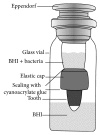Comparing the Coronal Seal of Different Thicknesses of MTA with Gutta-Percha after Post Space Preparation
- PMID: 25984559
- PMCID: PMC4423004
- DOI: 10.1155/2015/708639
Comparing the Coronal Seal of Different Thicknesses of MTA with Gutta-Percha after Post Space Preparation
Abstract
Introduction: The aim of this study was to compare the coronal seal of different thicknesses of MTA with gutta-percha after post space preparation.
Materials and methods: A total of 50 maxillary central incisors randomly divided into 5 experimental groups (n = 8). After preparation of the root canals with step back technique, in groups 1 and 2, post spaces were prepared and 4 or 5 mm gutta-percha remained in the apical, respectively. In groups 3, 4, and 5, there was 1-2 and 3 mm MTA in the apical, respectively. The ten teeth serve as control groups. The teeth were connected to a bacterial microleakage evaluation system. The study period was 120 days and the samples were evaluated on ten-day intervals; Meier-Kaplan technique was used for estimation of the mean time of microleakage to occur. Log-rank test was used for comparison of microleakage.
Results: Number of samples exhibiting microleakage in MTA was less than those of gutta-percha at all intervals. Means of days with no microleakage were maximum and minimum with 3 mm MTA and 4 mm gutta-percha, respectively.
Conclusion: Obturation of root canals using the MTA technique provides a proper seal with the minimum thickness of MTA in teeth requiring post space preparation.
References
-
- Schilder H. Filling root canals in three dimensions. Journal of Endodontics. 2006;11:723–724. - PubMed
-
- Galen W. W., Muller K. I. Restoration of endodontically treated teeth. Oral Surgery, Oral Medicine, Oral Pathology, Oral Radiology, and Endodontology. 2006;102:786–821.
MeSH terms
Substances
LinkOut - more resources
Full Text Sources
Other Literature Sources


